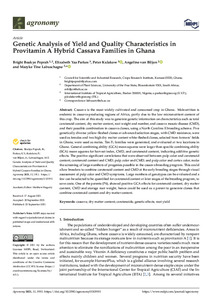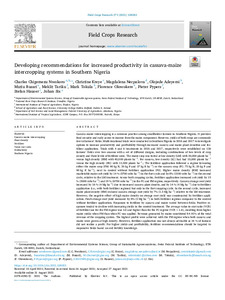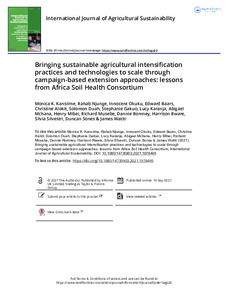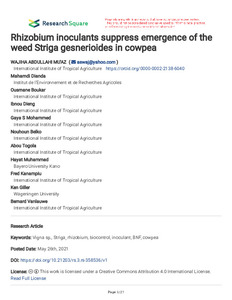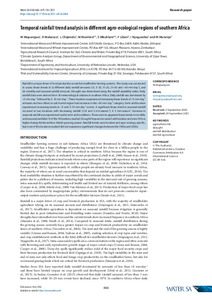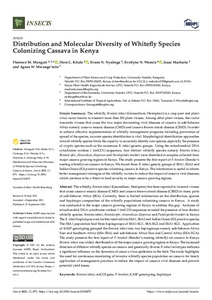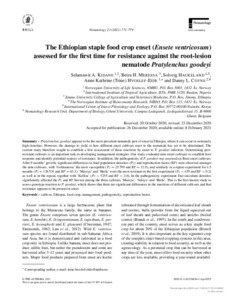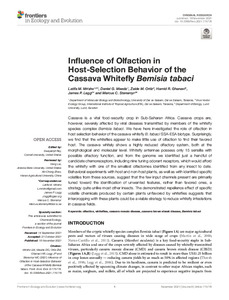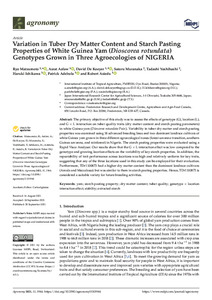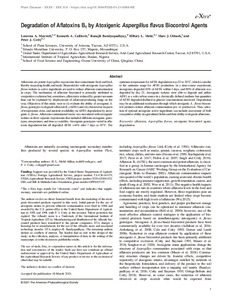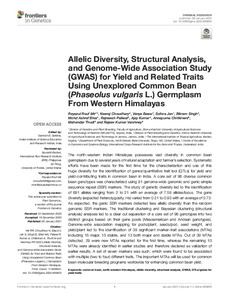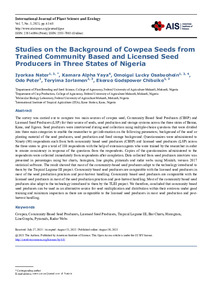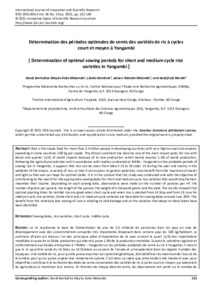Welcome to the International Institute of Tropical Agriculture Research Repository
Journal and Journal Articles: Recent submissions
Now showing items 801-820 of 5157
-
Genetic analysis of yield and quality characteristics in provitamin A hybrid cassava families in Ghana
(2021)Cassava is the most widely cultivated and consumed crop in Ghana. Malnutrition is endemic in cassava-producing regions of Africa, partly due to the low micronutrient content of this crop. The aim of this study was to generate genetic information on characteristics such as total carotenoid content, dry matter content, root weight and number, and cassava mosaic disease (CMD), and their possible combination in cassava clones, using a North Carolina II breeding scheme. Five genetically diverse ... -
Genetic diversity of local and introduced cassava germplasm in Burundi using DArTseq molecular analyses
(2022-01-24)In Burundi most small-scale farmers still grow traditional cassava landraces that are adapted to local conditions and have been selected for consumer preferred attributes. They tend to be susceptible, in varying degrees, to devastating cassava viral diseases such as Cassava Brown Streak Disease (CBSD) and Cassava Mosaic Disease (CMD) with annual production losses of US$1 billion. For long term resistance to the disease, several breeding strategies have been proposed. A sound basis for a breeding ... -
Potential of genomics for the improvement of underutilized legumes in sub-Saharan Africa
(2021)Underutilized, or orphan legumes, are widely distributed across farming landscapes in sub-Saharan Africa (SSA) but often have low yields and do not fulfill their potential due to very limited research, breeding, development, marketing, and awareness of their benefits. These advantages include nutritional quality and climate resilience. In this review, we focus on Bambara groundnut, African yam bean, and Kersting's groundnut. Knowledge of the challenges and rewards of exploiting them will provide ... -
On-farm assessment of cassava root yield response to tillage, plant density, weed control and fertilizer application in southwestern Nigeria
(2021)Cassava is growing in importance in Nigeria as a food and industrial crop. Current yields are low due to poor soil fertility and because farmers do not use improved germplasm, clean planting material, or improved crop management in Nigeria. To provide feasible agronomic recommendations targeting increased root yield, the effects of tillage intensity, fertilizer application, plant density and weed control were tested in 230 farmers’ fields in southwestern Nigeria over two years. In 2016, tillage ... -
Preliminary assessment of the association between DArT-SEQ SNP and some nutritional traits in African yam bean
(2021)African yam bean (AYB) is an underutilized tropical legume rich in protein and starch content. This study's aim was to use Diversity Arrays Technology (DArT) sequencing to study the ge-nome-wide association studies (GWAS) of nutritional traits. The study was carried out on 137 accessions in IITA, Ibadan. Seeds were harvested at maturity and analysed for protein, oil, and starch using Kjeltec, Soxtec, and Phenol-sulfuric acid assay method. Mixed Linear Model (MLM) was used for GWAS analysis by ... -
Banana seed genetic resources for food security: status, constraints, and future priorities
(2021)Storing seed collections of crop wild relatives, wild plant taxa genetically related to crops, is an essential component in global food security. Seed banking protects genetic resources from degradation and extinction and provides material for use by breeders. Despite being among the most important crops in the world, banana and plantain crop wild relatives are largely under-represented in genebanks. Nevertheless, banana crop wild relative seed collections are in fact held in different countries, ... -
Developing recommendations for increased productivity in cassava-maize intercropping systems in southern Nigeria
(2021)Cassava-maize intercropping is a common practice among smallholder farmers in Southern Nigeria. It provides food security and early access to income from the maize component. However, yields of both crops are commonly low in farmers’ fields. Multi-locational trials were conducted in Southern Nigeria in 2016 and 2017 to investigate options to increase productivity and profitability through increased cassava and maize plant densities and fertilizer application. Trials with 4 and 6 treatments in 2016 ... -
Bringing sustainable agricultural intensification practices and technologies to scale through campaign-based extension approaches: lessons from Africa Soil Health Consortium
(2021)Sustainable agricultural intensification (SAI) practices have been developed with the aim of increasing agricultural productivity. However, most of them are not achieving their potential because of low adoption, linked to limited extension support to make them known and accessible by end-users. This paper reviews the effectiveness of the Africa Soil Health Consortium (ASHC) extension-based campaigns, contributing knowledge for formulating novel and cost-effective extension approaches. Results show ... -
Rhizobium inoculants suppress emergence of the weed Striga gesnerioides in cowpea
(2021)Cowpea is a grain legume of major importance in sub-Saharan Africa where it is cultivated by smallholder farmers on poor soils and production is often constrained by the parasitic weed Striga gesnerioides. Experiments were conducted to assess the potential of rhizobium inoculation in mitigating Striga infestation and increasing cowpea productivity. We tested under basal P application and artificial S. gesnerioides inoculation the impact of cowpea genotypes (G) (nine Striga-resistant and 11 Striga– ... -
Temporal rainfall trend analysis in different agro-ecological regions of southern Africa
(2021-10)Rainfall is a major driver of food production in rainfed smallholder farming systems. This study was conducted to assess linear trends in (i) different daily rainfall amounts (<5, 5–10, 11–20, 21–40 and >40 mm∙day-1), and (ii) monthly and seasonal rainfall amounts. Drought was determined using the rainfall variability index. Daily rainfall data were derived from 18 meteorological stations in southern Africa. Daily rainfall was dominated by <5 mm∙day-1 followed by 5–10 mm∙day -1. Three locations ... -
Mechanisms and approaches towards enhanced drought tolerance in cassava (Manihot esculenta)
(2021)Cassava (Manihot esculenta Crantz) is cultivated in tropical and subtropical regions for its edible tuberous roots and minimally for its leaves. It provides food and revenue to over eight hundred million people particularly in Africa. Generally, cassava is drought-tolerant, and sheds leaves in drought conditions resulting in significantly lower yields. Cassava drought management strategies need to focus on maximizing the utilization of molecular tools for crop establishment and yield. Developing ... -
Distribution and molecular diversity of whitefly species colonizing cassava in Kenya
(2021)The whitefly, Bemisia tabaci (Gennadium, Hemiptera) has been reported to transmit viruses that cause cassava mosaic disease (CMD) and cassava brown streak disease (CBSD) in many parts of sub-Saharan Africa (SSA). Currently, there is limited information on the distribution, species and haplotype composition of the whitefly populations colonizing cassava in Kenya. A study was conducted in the major cassava growing regions of Kenya to address this gap. Analyses of mitochondrial DNA cytochrome oxidase ... -
The Ethiopian staple food crop enset (Ensete ventricosum) assessed for the first time for resistance against the root-lesion nematode Pratylenchus goodeyi
(2021)Pratylenchus goodeyi appears to be the most prevalent nematode pest of enset in Ethiopia, where it can occur in extremely high densities. However, the damage to yield or how different enset cultivars react to the nematode has yet to be determined. The current study therefore sought to establish a first assessment of these reactions by enset to P. goodeyi infection. Determining pest-resistant cultivars is an important task in developing management strategies. Our study evaluated nine enset cultivars ... -
Influence of olfaction in host-selection behavior of the cassava whitefly Bemisia tabaci
(2021-11)Cassava is a vital food-security crop in Sub-Saharan Africa. Cassava crops are, however, severely affected by viral diseases transmitted by members of the whitefly species complex Bemisia tabaci. We have here investigated the role of olfaction in host selection behavior of the cassava whitefly B. tabaci SSA-ESA biotype. Surprisingly, we find that the whiteflies appear to make little use of olfaction to find their favored host. The cassava whitely shows a highly reduced olfactory system, both at ... -
Variation in tuber dry matter content and starch pasting properties of white Guinea yam (Dioscorea rotundata) genotypes grown in three groecologies of Nigeria
(2021)The primary objective of this study was to assess the effects of genotype (G), location (L), and G × L interaction on tuber quality traits (dry matter content and starch pasting parameters) in white Guinea yam (Dioscorea rotundata Poir.). Variability in tuber dry matter and starch pasting properties was examined using 18 advanced breeding lines and two dominant landrace cultivars of white Guinea yam grown in three different agroecological zones (forest‒savanna transition, southern Guinea savanna, ... -
Degradation of aflatoxins B1 by atoxigenic Aspergillus flavus biocontrol agents
(2021-09)Aflatoxins are potent Aspergillus mycotoxins that contaminate food and feed, thereby impacting health and trade. Biopesticides with atoxigenic Aspergillus flavus isolates as active ingredients are used to reduce aflatoxin contamination in crops. The mechanism of aflatoxin biocontrol is primarily attributed to competitive exclusion but, sometimes, aflatoxin is reduced by greater amounts than can be explained by displacement of aflatoxin-producing fungi on the crop. Objectives of this study were to ... -
Allelic diversity, structural analysis, and genome-wide association study (GWAS) for yield and related traits using unexplored common bean (Phaseolus vulgaris L.) Germplasm from Western Himalayas
(2021-01)The north-western Indian Himalayas possesses vast diversity in common bean germplasm due to several years of natural adaptation and farmer’s selection. Systematic efforts have been made for the first time for the characterization and use of this huge diversity for the identification of genes/quantitative trait loci (QTLs) for yield and yield-contributing traits in common bean in India. A core set of 96 diverse common bean genotypes was characterized using 91 genome-wide genomic and genic simple ... -
Studies on the background of cowpea seeds from trained community based and licensed seed producers in three states of Nigeria
(2021)The survey was carried out to compare two main sources of cowpea seed, Community Based Seed Producers (CBSP) and Licensed Seed Producers (LSP) for their source of seeds, seed production and storage systems across the three states of Benue, Kano, and Jigawa. Seed producers were interviewed during seed collection using multiple-choice questions that were divided into three main categories to enable the researcher to get information on the following parameters; background of the seed or planting ... -
Characterizing cassava farmer typologies and their seed sourcing practices to explore opportunities for economically sustainable seed business models in Rwanda
(2021)The overdependency on local cassava varieties and informal seed sources by farmers in Rwanda has contributed to the spread of cassava viral diseases. The use of improved planting materials made available through formal seed sources, that assure seed quality, is one way to prevent future disease outbreaks. In order to increase the availability of, and farmers access to, such materials there is increasing interest to develop seed business models. This study aims to understand seed sourcing practices ... -
Determination des periodes optimales de semis des varietes de riz a cycles court et moyen a Yangambi
(2021-09)Rice is the staple food for more than 2.5 billion people in developing countries with very high annual consumption exceeding in some countries 100 kg per capita. The African continent has become one of the main import poles for rice with about one quarter (1/4) of world imports because of its low production, which barely reaches 1.5% of world production. Following the agricultural calendar and in accordance with studies conducted at INERA - Yangambi on the probable periods of sowing rice in Yangambi, ...

